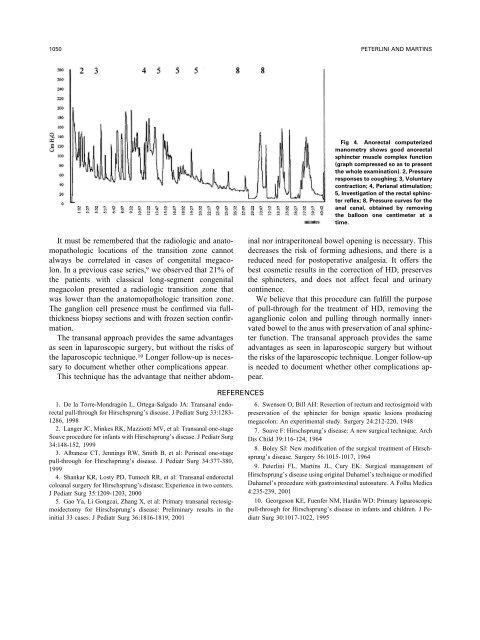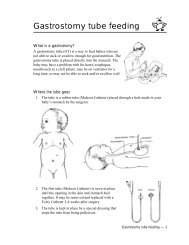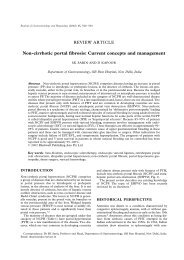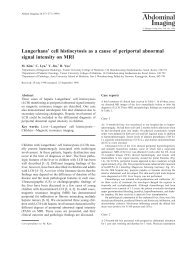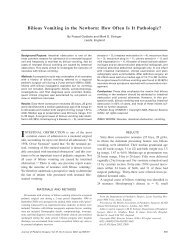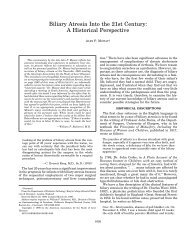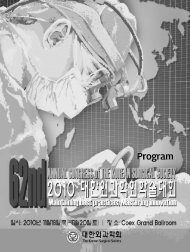Modified Transanal Rectosigmoidectomy for ... - Biliaryatresia.org
Modified Transanal Rectosigmoidectomy for ... - Biliaryatresia.org
Modified Transanal Rectosigmoidectomy for ... - Biliaryatresia.org
You also want an ePaper? Increase the reach of your titles
YUMPU automatically turns print PDFs into web optimized ePapers that Google loves.
1050 PETERLINI AND MARTINS<br />
Fig 4. Anorectal computerized<br />
manometry shows good anorectal<br />
sphincter muscle complex function<br />
(graph compressed so as to present<br />
the whole examination). 2, Pressure<br />
responses to coughing; 3, Voluntary<br />
contraction; 4, Perianal stimulation;<br />
5, Investigation of the rectal sphincter<br />
reflex; 8, Pressure curves <strong>for</strong> the<br />
anal canal, obtained by removing<br />
the balloon one centimeter at a<br />
time.<br />
It must be remembered that the radiologic and anatomopathologic<br />
locations of the transition zone cannot<br />
always be correlated in cases of congenital megacolon.<br />
In a previous case series, 9 we observed that 21% of<br />
the patients with classical long-segment congenital<br />
megacolon presented a radiologic transition zone that<br />
was lower than the anatomopathologic transition zone.<br />
The ganglion cell presence must be confirmed via fullthickness<br />
biopsy sections and with frozen section confirmation.<br />
The transanal approach provides the same advantages<br />
as seen in laparoscopic surgery, but without the risks of<br />
the laparoscopic technique. 10 Longer follow-up is necessary<br />
to document whether other complications appear.<br />
This technique has the advantage that neither abdominal<br />
nor intraperitoneal bowel opening is necessary. This<br />
decreases the risk of <strong>for</strong>ming adhesions, and there is a<br />
reduced need <strong>for</strong> postoperative analgesia. It offers the<br />
best cosmetic results in the correction of HD, preserves<br />
the sphincters, and does not affect fecal and urinary<br />
continence.<br />
We believe that this procedure can fulfill the purpose<br />
of pull-through <strong>for</strong> the treatment of HD, removing the<br />
aganglionic colon and pulling through normally innervated<br />
bowel to the anus with preservation of anal sphincter<br />
function. The transanal approach provides the same<br />
advantages as seen in laparoscopic surgery but without<br />
the risks of the laparoscopic technique. Longer follow-up<br />
is needed to document whether other complications appear.<br />
1. De la Torre-Mondragón L, Ortega-Salgado JA: <strong>Transanal</strong> endorectal<br />
pull-through <strong>for</strong> Hirschsprung’s disease. J Pediatr Surg 33:1283-<br />
1286, 1998<br />
2. Langer JC, Minkes RK, Mazziotti MV, et al: <strong>Transanal</strong> one-stage<br />
Soave procedure <strong>for</strong> infants with Hirschsprung’s disease. J Pediatr Surg<br />
34:148-152, 1999<br />
3. Albanese CT, Jennings RW, Smith B, et al: Perineal one-stage<br />
pull-through <strong>for</strong> Hirschsprung’s disease. J Pediatr Surg 34:377-380,<br />
1999<br />
4. Shankar KR, Losty PD, Tumoch RR, et al: <strong>Transanal</strong> endorectal<br />
coloanal surgery <strong>for</strong> Hirschsprung’s disease; Experience in two centers.<br />
J Pediatr Surg 35:1209-1203, 2000<br />
5. Gao Ya, Li Gongcai, Zhang X, et al: Primary transanal rectosigmoidectomy<br />
<strong>for</strong> Hirschsprung’s disease: Preliminary results in the<br />
initial 33 cases. J Pediatr Surg 36:1816-1819, 2001<br />
REFERENCES<br />
6. Swenson O, Bill AH: Resection of rectum and rectosigmoid with<br />
preservation of the sphincter <strong>for</strong> benign spastic lesions producing<br />
megacolon: An experimental study. Surgery 24:212-220, 1948<br />
7. Soave F: Hirschsprung’s disease: A new surgical technique. Arch<br />
Dis Child 39:116-124, 1964<br />
8. Boley SJ: New modification of the surgical treatment of Hirschsprung’s<br />
disease. Surgery 56:1015-1017, 1964<br />
9. Peterlini FL, Martins JL, Cury EK: Surgical management of<br />
Hirschsprung’s disease using original Duhamel’s technique or modified<br />
Duhamel’s procedure with gastrointestinal autosuture. A Folha Medica<br />
4:235-239, 2001<br />
10. Ge<strong>org</strong>eson KE, Fuenfer NM, Hardin WD: Primary laparoscopic<br />
pull-through <strong>for</strong> Hirschsprung’s disease in infants and children. J Pediatr<br />
Surg 30:1017-1022, 1995


